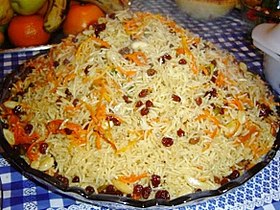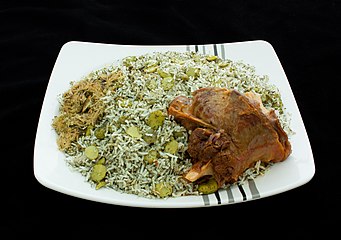Pilaf
 Kabuli palaw, the national dish of Afghanistan | |
| Jeneng liyané | Polao, Pela, Pilav, Pallao, Pilau, Pelau, Pulao, Pulaav, Palaw, Palavu, Plov, Palov, Polov, Polo, Polu, Kurysh, Fulao, Fulaaw, Fulav, Fulab, Osh, Aş |
|---|---|
| Ajangan | Main |
| Tlatah utawa praja | Balkans, Caribbean, South Caucasus, Central Asia, East Africa, Eastern Europe, Latin America, Middle East, and South Asia |
| Hawa ajangan | Hot |
| Woworan pokok | Rice, stock or broth, spices, meat, vegetables, dried fruits |
Pilaf (pocapan AS ) utawa pilau (pocapan Inggris ) utawa Polao (pocapan Bangla ) minangka sajian sega, utawa ing sawétara wilayah, sajian gandum, ing resep biasané melu masak ing duduh utawa duduh kaldu, nambah rempah-rempah, lan bahan liyané kaya ta janganan utawa daging, [1] [2] [3] [4] lan nggunakaké sawétara teknik kanggo nggayuh pari sing dimasak sing ora manut. [5] [7] [8] [10]
Ing wektu Khalifah Abbasiyah, metode masak nasi iki wiwit nyebar ing wilayah sing gedhe saka India nganti Spanyol, lan pungkasané dadi jagad sing luwih akéh. Paella Spanyol, [8] [12] lan pilau Asia Kidul utawa pulao, [13] [15] lan biryani, [16] [18] berkembang saka sajian kaya ngono.
Pilaf lan panganan sing padha yaiku umum kanggo Balkan, Karibia, Kaukasia Kidul, Asia Tengah, Afrika Wétan, Eropa Wétan, Amerika Latin, Timur Tengah, lan Masakan Asia Kidul . Iki minangka panganan pokok lan sajian sing kawentar ing Afghanistan, Armenia, Azerbaijan, Bangladesh, China ( utamané ing Xinjiang ), Siprus, Georgia, Yunani ( utamané ing Kreta ), India, Irak ( mligine ing Kurdistan ), Iran, Israel,[19] Kazakhstan, Kenya, Kyrgyzstan, Nepal, Pakistan, Rumania, Ruslan, Tanzania ( utamané ing Zanzibar ), Tajikistan,[20] Turkey,[21] Turkmenistan, Uganda, lan Uzbekistan .[22][23]
Gladri
[besut | besut sumber]-
Pilaf karo lawuh
-
Pilaf nganggo lemon lan jagung
-
Sapiring pilaf
Kapustakan
[besut | besut sumber]- ↑ a b Oxford English Dictionary 2006b.
- ↑ Oxford English Dictionary (subscription required): "A dish, partly of Middle Eastern, partly and ultimately of South Asian origin, consisting of rice (or, in certain areas, wheat) cooked in stock with spices, usually mixed with meat and various other ingredients.[1]
- ↑ a b Merriam-Webster Unabridged Dictionary 2019.
- ↑ Merriam-Webster Unabridged Dictionary (subscription required): "rice usually combined with meat and vegetables, fried in oil, steamed in stock, and seasoned with any of numerous herbs (as saffron or curry)."[3]
- ↑ Perry 2014.
- ↑ Perry 2014, kc. 624.
- ↑ Perry: "A Middle-Eastern method of cooking rice so that every grain remains separate. ...However, there is no evidence that rice was cooked by this technique in India before the Muslim invasions, and Indians themselves associate pilaf-making with Muslim cities such as Hyderabad, Lucknow, and Delhi. .... The first descriptions of the pilaf technique appear in the 13th-century Arabic books Kitab al-Tabikh and Kitab al-Witsla ila al Habib, written in Baghdad and Syria, respectively. They show the technique in its entirety, including the cloth beneath the lid, and describe still-current flavourings such as meat, pulses, and fruit.[6]
- ↑ a b Roger 2000.
- ↑ Roger 2000, kc. 1144.
- ↑ Roger: "As noted, Iranians have a unique method of preparing rice. This method is designed to leave the grains separate and tasty, making the rice fluffy and very flavorful. After soaking, parboiling, and draining, the rice is poured into a dish smeared with melted butter. The lid is then sealed tightly with a cloth and a paste of flour and water. The last stage is to steam it on low heat for about half an hour, after which the rice is removed and fluffed."[9]
- ↑ Roger 2000, kc. 1143.
- ↑ Roger: " (p. 1143) Under the Abbassids, for example (ninth to twelfth century), during the Golden Age of Islam, there was one single empire from Afghanistan to Spain and the North of Arabia. The size of the empire allowed many foods to spread throughout the Middle East. From India, rice went to Syria, Iraq, and Iran, and eventually, it became known and cultivated all the way to Spain. .... Many dishes of that period are still prepared today with ingredients available to the common people. Some of these are vinegar preserves, roasted meat, and cooked livers, which could be bought in the streets, eaten in the shops, or taken home. Such dishes considerably influenced medieval European and Indian cookery;pilaf and meat patties that started out as samosa or sambusak."[11]
- ↑ Nandy 2004.
- ↑ Nandy 2004, kc. 11.
- ↑ Nandy: "(p. 11) All around India one finds preparations that came originally from outside South Asia. Kebabs came from West and Central Asia and underwent radical metamorphosis in the hot and dusty plains of India. So did biryani and pulao, two rice preparations, usually with meat. Without them, ceremonial dining in many parts of India, Pakistan, and Bangladesh is incomplete."[14]
- ↑ Sengupta 2014.
- ↑ Sengupta 2014, kc. 74.
- ↑ Sengupta: "(p. 74) Muslim influence on the style and substance of Indian food was profound. K.T. Achaya writes that the Muslims imported a new refinement and a courtly etiquette of both group and individual dining into the austere dining ambience of Hindu society. ... Babur's son, Humayun, came back to India after spending a long period of exile in Kabul and the Safavid imperial court in Iran. He brought with him an entourage of Persian cooks who introduced the rich and elaborate rice cookery of the Safavid courts to India, combining Indian spices and Persian arts into a rich fusion that became the iconic dish of Islamic South Asian cuisine, the biryani."[17]
- ↑ Gil Marks. Encyclopedia of Jewish Food. Houghton Mifflin Harcourt, 2010. ISBN 9780544186316
- ↑ Marshall Cavendish. World and Its Peoples. Marshall Cavendish, 2006, p. 662. ISBN 9780761475712
- ↑ Navy Bean Stew And Rice Is Turkey's National Dish Archived 2018-12-26 at the Wayback Machine. turkishfood.about.com
- ↑ Bruce Kraig, Colleen Taylor Sen. Street Food Around the World: An Encyclopedia of Food and Culture. ABC-CLIO, 2013, p. 384. ISBN 9781598849554
- ↑ Russell Zanca. Life in a Muslim Uzbek Village: Cotton Farming After Communism CSCA. Cengage Learning, 2010, p. 92 92–96. ISBN 9780495092810



